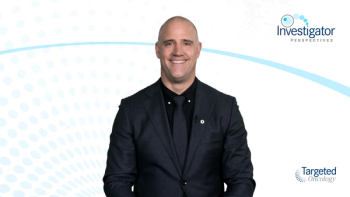
ZETA and EXAM Clinical Trial Data
Dr Marcia Brose reviews key efficacy and safety data from the phase 3 ZETA and EXAM clinical trials.
Episodes in this series

Marcia Brose, MD: From the NCCN [National Comprehensive Cancer Network] Guidelines, we know that vandetanib and cabozantinib are category 1. They both have phase 3 data that support them, and they were FDA approved in this indication. Interestingly, they were approved before we were doing regular RET testing, and the data show that they’re active in all types of medullary thyroid cancer. That’s just a point to put out there; these are agents that can be used regardless of RET status. We’re using it because we’ve presumably already siphoned off our RET mutated and treated them with other agents. In our case, vandetanib and cabozantinib are the only ones approved.
Just a quick review of the data: these have been out for over 10 years. Basically the trial was a group of patients who had medullary thyroid cancer that was unresectable or locally advanced, and it randomized patients between getting vandetanib and placebo. A point that’s always important to note is that the placebo has a very long progression presurvival, because progression of disease wasn’t required as an eligibility criterion. There was obviously a significant number of patients who had somewhat indolent disease in this study; that’s why the placebo arm did so well. But there was an overall response rate of 45% in the vandetanib arm, which was statistically significant. Disease-control rate was 87%. There was a biochemical response as well. The hazard ratio was 0.89. Based on these data, this became the first FDA-approved drug for medullary thyroid cancer.
Let me look at the subtypes again. Getting back to the point, RET-mutation positive as well as negative. There weren’t as many that were known. For the RET-mutation-negative group, it was such a small number: it’s overlapping the 1.0 hazard ratio. It was clear that all patients were benefiting, regardless of whether they were RET-mutation positive, M918T positive. I have a hard time saying that patients who were RET-mutation negative didn’t get benefit, because the numbers are so small. It’s reassuring to know that the patients who had RET mutations did also get a benefit; it’s something to keep in mind if they ever progress after our selective RET inhibitors. The overall toxicity of these agents is a little broader, because they are VEGF receptor inhibitors as well as RET inhibitors. Diarrhea, rash, nausea, and hypertension are common in this class. Fatigue and headache are also, and some decreased appetites.
Significant in this group of drugs that inhibit VEGF receptor, we see all these in different proportions, in slightly different orders, maybe not quite as much hypertension as we see with lenvatinib, but diarrhea was also a significant adverse event [AE] in patients with this. It was a common reason why patients needed to dose reduce. You can see 25% of patients had grade 3 diarrhea, and 20% had grade 3 hypertension. Another thing that was significant in vandetanib is that there’s quite a bit of QTc prolongation. This agent requires ECGs [electrocardiographs] or surveillance while you’re doing treatment to make sure the QT prolongation doesn’t get too long and put people at risk of torsade. I have a couple of patients who periodically must take a bit of a break but then are able to be rechallenged at the same dose and do pretty well. We monitor them for this on a regular basis.
The exam trial was for cabozantinib, and it randomized patients between cabozantinib and placebo as well. This time, unlike the prior study, did require progressive disease prior to entering; therefore, the placebo, the PFS [progression-free survival], was only 4 months. In the cabozantinib arm, the progression-free survival, was 11.2 months. This has a hazard ratio of 0.28, which is highly statistically significant. It’s very important for our patients. There was a response rate of 34% for patients with the 918T RET mutation, as well as 20% response rate for patients who didn’t have the 918T mutation. This was broadly active in patients with metastatic medullary thyroid cancer. Overall survival wasn’t significant in this study. It was not that they had crossover within the study but because there were other agents available. There was basically crossover between patients getting other agents following progression. Overall survival wasn’t considered different. It was interesting that there seemed to be a trend toward patients having an improved overall survival if they were RET positive. Especially with the 918T, that was the 1 that did achieve statistical significance. It seems that patients who had RET mutations benefited even more than the average patient who didn’t have RET mutation. Maybe it’s because a lot of those patients had RAS mutations. But all of them seemed to be benefiting from this agent. This is a widely active agent—RET positive, RET negative—and was also very active in patients who had clearly active, progressive disease. It was a little more of aggressive population that what we had studied in the data trial.
Diarrhea, weight loss, and some skin reaction was seen. There seemed to be a little more toxicity than vandetanib, with more patients having all-grades diarrhea and weight loss. But when we look at grade 3, diarrhea became a significant issue. It didn’t always start right away, but there was much more of a significant issue, with 21% of patients having diarrhea and having skin reactions. Interestingly, with cabozantinib, there was a bit of a difference. Patients find whatever dose they managed up front; then they seemed to do well for a while, and then they would get the dwindles. We found that if we then stopped the dose, gave them a holiday for a couple of weeks, saw them eating again and things like that, and lower the dose, then they might go another 8 or 9 months. Then get the dwindles, repeat the holiday, repeat the dose reduction. We’ve had patients who did well over 3 to 5 years, until they ended up even on every other day dosing. This was an unusual thing that I hadn’t seen so much with the other kinase inhibitors, as far as the profile of managing the toxicity. But clearly, this was more toxic than the RET inhibitors that we had seen.
If we look at how many people discontinued treatment, in the exam trial 82% had dose reductions in the cabozantinib arm, and 46% underwent a second dose. Similar to what I just relayed. Patients who discontinued treatment—at some point they all discontinued treatment—did it because of their progressive disease at the end of their getting value from the drugs. Another 22% ended up going off therapy because of AEs. There still were some in the placebo arm who went off, but most likely these adverse events were because of the disease and not the drug. Interestingly, the rate of death was similar in both arms, as reasons of patients going off the drug.
This transcript has been edited for clarity.










































